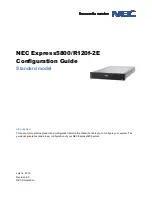
Node Host Name, IP Address and DNS
VSky storage servers support simultaneous S3, NAS and iSCSI operations using the same physical storage
resources. A multi-node VSky server cluster needs to create redundancy for high availability, therefore it must
have some failover mechanism to continue operations in the event of a node going offline. How the IP settings for
the nodes and how DNS services for resolving the host names of the nodes is handled in a failover situation is key
to providing continuity of operations for S3, NAS and iSCSI clients. The basics of how this done is discussed here.
Each node in the VSky cluster is connected to a different group of clients. These clients are using NAS, S3 or
iSCSI to create the connection. For NAS and iSCSI clients, each node functions in the role of a gateway device.
For S3 clients, each node functions as an Object Storage Device (OSD), a concept specific to object storage.
On the
Public
(client side) IP interface, each connection type (
NAS
,
iSCSI
,
S3
) uses a different method to enable
clients to locate the gateway or OSD.
To help understand how failover works, it is first necessary to describe the roles performed by the Host Name,
IP address, and DNS IP address in making the client-to-node connection. Then we describe how these are
carried over to another node so the affected clients do not lose access to storage resources.
Host Name:
Each node in a cluster is given a Host Name that is unique in the cluster, or in the Virtual
Storage. For S3 clients, the Host Name is translated to the real IP address of a node by DNS. For NAS
clients, the Host Name is translated to the Takover IP Address by DNS.
DNS:
DNS service resolves the Host Name of a node with its IP address for S3 clients, and with its
Takeover IP address for NAS clients. Note that iSCSI clients also use the Takeover IP Address to connect
to a node, but iSCSI does not require DNS, the Takeover IP Address is manually assigned to the iSCSI
client during the setup procedure.
IP Settings:
Keep in mind there are two IP interfaces involved, the Public IP address used to connect
clients to the server cluster, and the Cluster/Storage IP addresses of the nodes used only for identification
among the nodes in the cluster. Each IP interface is physically separate and operate on different IP
domains. For example, the
Public
IP domain might use the 10.0.0.x (IP address range commonly used for
Class A private networks); and the
Cluster/Storage
domain would use the 192.168.0.x (IP address range
commonly used for Class C private networks).
Takover IP Address:
This is a form of virtual IP address used to connect NAS clients and iSCSI clients
to a specific node on the Public IP interface. A Takeover IP address is assigned to each node in order to
create a failover mechanism. As previously stated, NAS clients use DNS to resolve the Host Name to the
Takeover IP address. If there is no Takeover IP address, NAS clients are not able to connect because the
Host Name cannot be resolved. iSCSI clients can be setup to connect to the real IP address of a node,
but in that case there would not be a failover mechanism to continue connection in the event of a node
going offline (see “NAS/iSCSI failover example - Takeover IP Address” on page 65
).
S3 clients do not use the Takeover IP address. Object storage clients use the real IP address of a node
(or Object Storage Device), and the failover mechanism works differently (see
There is no failover mechanism for the Cluster/Storage IP interface. Redundancy is built-in, because
stored data paired with the offline node is duplicated on the storage resources connected to the healthy
nodes. Therefore losing a node in the cluster does not cut off access to data.
64
VSky A1100 Product Manual
Promise Technology, Inc.
















































